1997 MERCEDES-BENZ ML350 oil change
[x] Cancel search: oil changePage 3048 of 4133
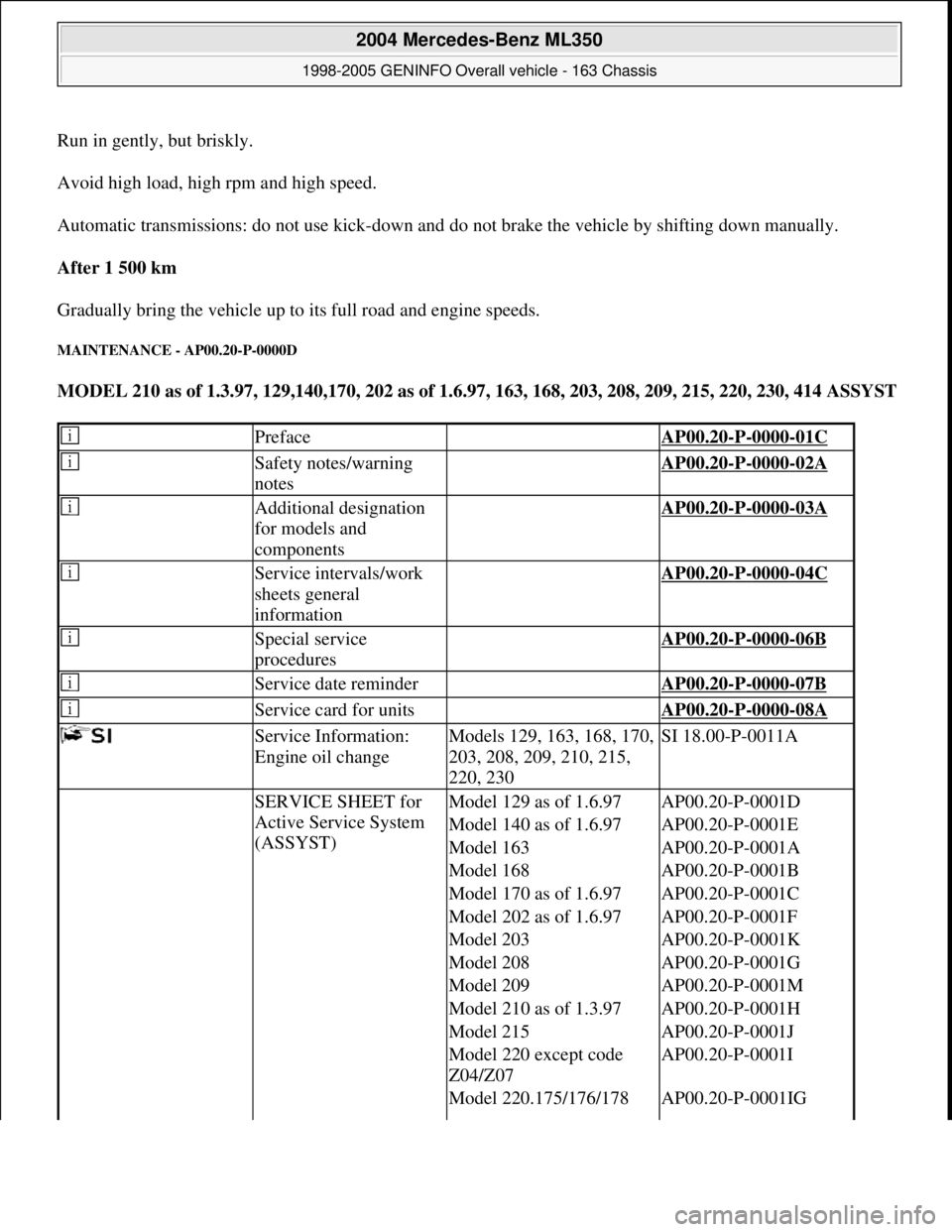
Run in gently, but briskly.
Avoid high load, high rpm and high speed.
Automatic transmissions: do not use kick-down and do not brake the vehicle by shifting down manually.
After 1 500 km
Gradually bring the vehicle up to its full road and engine speeds.
MAINTENANCE - AP00.20-P-0000D
MODEL 210 as of 1.3.97, 129,140,170, 202 as of 1.6.97, 163, 168, 203, 208, 209, 215, 220, 230, 414 ASSYST
Preface AP00.20-P-0000-01C
Safety notes/warning
notes AP00.20-P-0000-02A
Additional designation
for models and
components AP00.20-P-0000-03A
Service intervals/work
sheets general
information AP00.20-P-0000-04C
Special service
procedures AP00.20-P-0000-06B
Service date reminder AP00.20-P-0000-07B
Service card for units AP00.20-P-0000-08A
Service Information:
Engine oil changeModels 129, 163, 168, 170,
203, 208, 209, 210, 215,
220, 230SI 18.00-P-0011A
SERVICE SHEET for
Active Service System
(ASSYST)Model 129 as of 1.6.97AP00.20-P-0001D
Model 140 as of 1.6.97AP00.20-P-0001E
Model 163AP00.20-P-0001A
Model 168AP00.20-P-0001B
Model 170 as of 1.6.97AP00.20-P-0001C
Model 202 as of 1.6.97AP00.20-P-0001F
Model 203AP00.20-P-0001K
Model 208AP00.20-P-0001G
Model 209AP00.20-P-0001M
Model 210 as of 1.3.97AP00.20-P-0001H
Model 215AP00.20-P-0001J
Model 220 except code
Z04/Z07AP00.20-P-0001I
Model 220.175/176/178 AP00.20-P-0001IG
2004 Mercedes-Benz ML350
1998-2005 GENINFO Overall vehicle - 163 Chassis
me
Saturday, October 02, 2010 3:47:52 PMPage 403 © 2006 Mitchell Repair Information Company, LLC.
Page 3061 of 4133
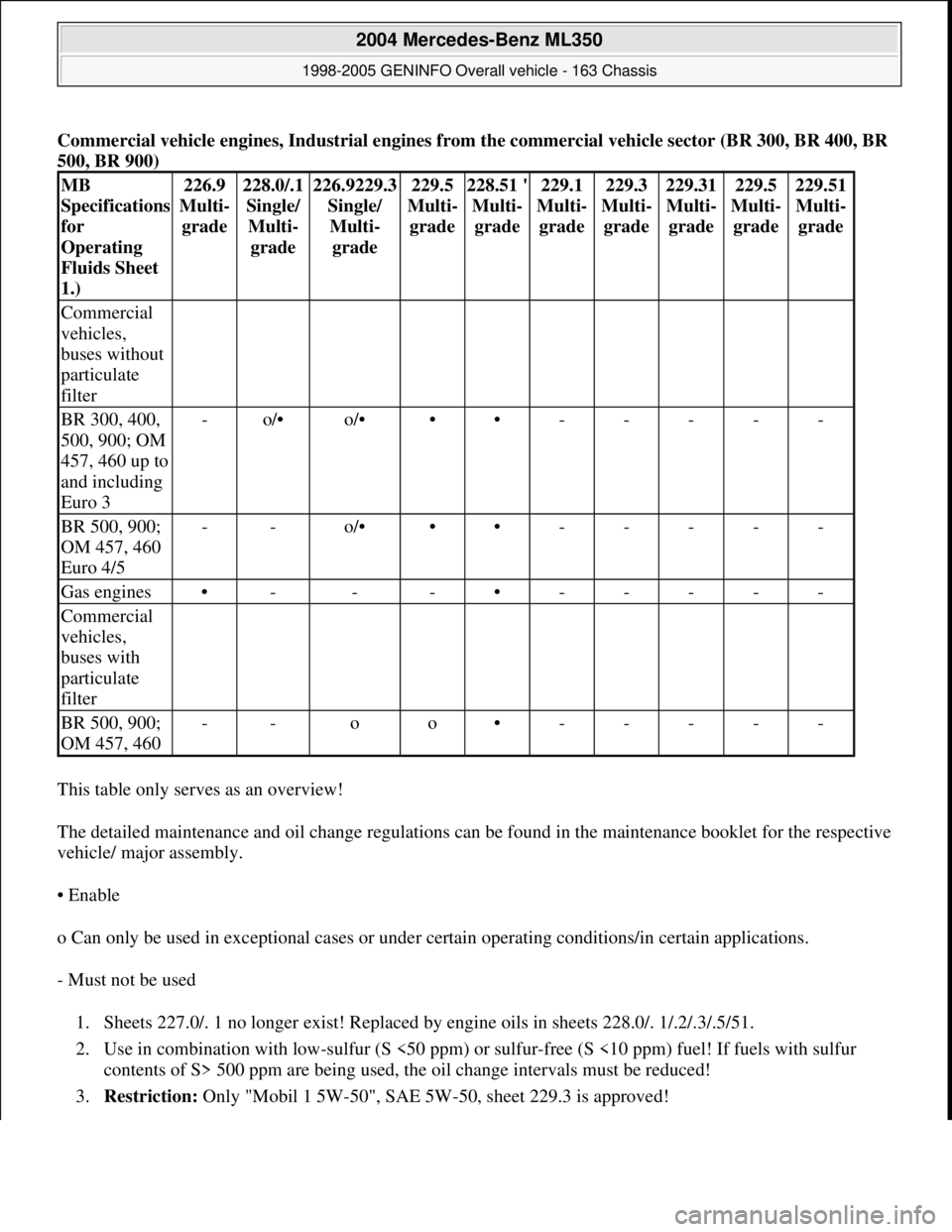
Commercial vehicle engines, Industrial engines from the commercial vehicle sector (BR 300, BR 400, BR
500, BR 900)
This table only serves as an overview!
The detailed maintenance and oil change regulations can be found in the maintenance booklet for the respective
vehicle/ major assembly.
• Enable
o Can only be used in exceptional cases or under certain operating conditions/in certain applications.
- Must not be used
1. Sheets 227.0/. 1 no longer exist! Replaced by engine oils in sheets 228.0/. 1/.2/.3/.5/51.
2. Use in combination with low-sulfur (S <50 ppm) or sulfur-free (S <10 ppm) fuel! If fuels with sulfur
contents of S> 500 ppm are being used, the oil change intervals must be reduced!
3.Restriction: Onl
y "Mobil 1 5W-50", SAE 5W-50, sheet 229.3 is approved!
MB
Specifications
for
Operating
Fluids Sheet
1.)226.9
Multi-
grade228.0/.1
Single/
Multi-
grade226.9229.3
Single/
Multi-
grade229.5
Multi-
grade228.51 '
Multi-
grade229.1
Multi-
grade229.3
Multi-
grade229.31
Multi-
grade229.5
Multi-
grade229.51
Multi-
grade
Commercial
vehicles,
buses without
particulate
filter
BR 300, 400,
500, 900; OM
457, 460 up to
and including
Euro 3-o/•o/•••-----
BR 500, 900;
OM 457, 460
Euro 4/5--o/•••-----
Gas engines•---•-----
Commercial
vehicles,
buses with
particulate
filter
BR 500, 900;
OM 457, 460--oo•-----
2004 Mercedes-Benz ML350
1998-2005 GENINFO Overall vehicle - 163 Chassis
me
Saturday, October 02, 2010 3:47:52 PMPage 416 © 2006 Mitchell Repair Information Company, LLC.
Page 3147 of 4133
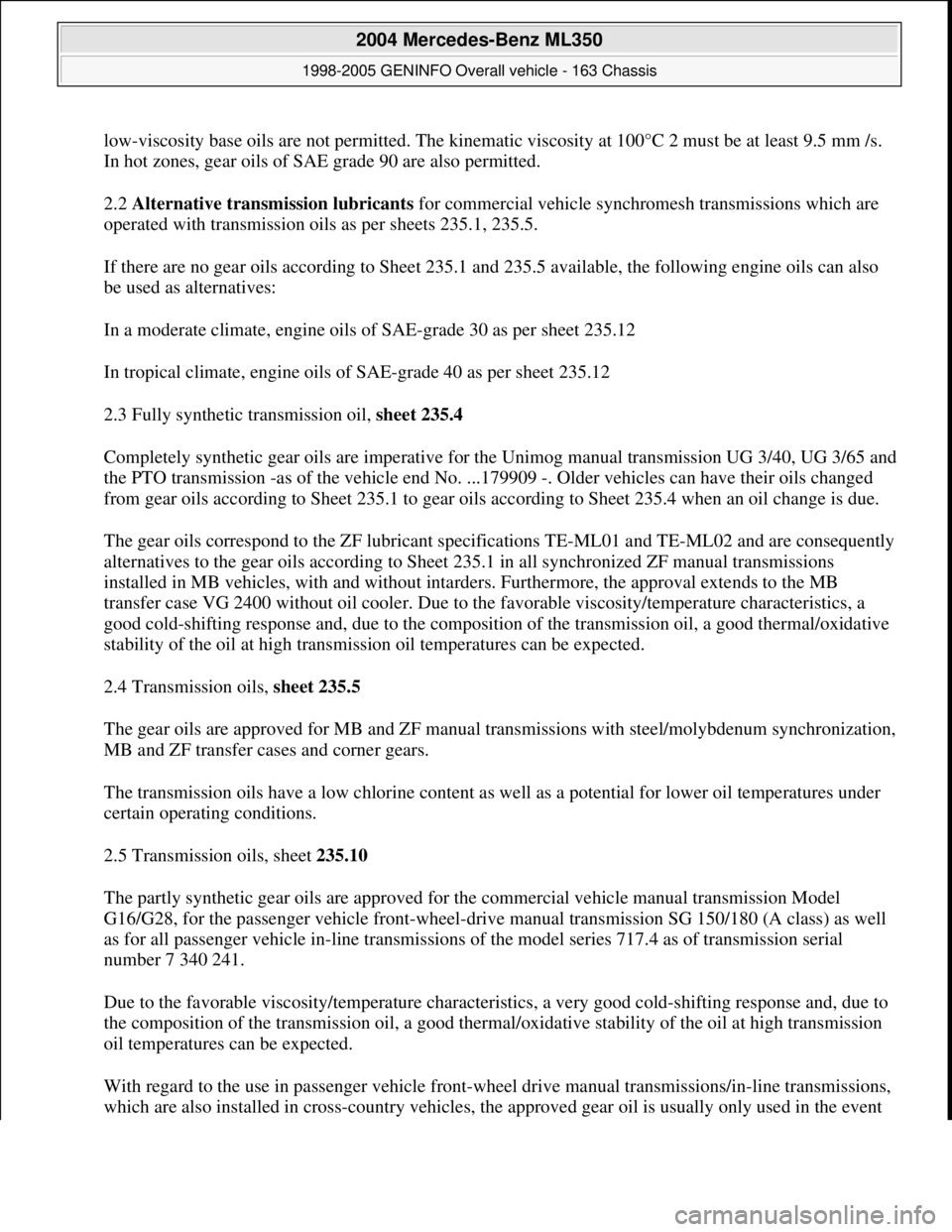
low-viscosity base oils are not permitted. The kinematic viscosity at 100°C 2 must be at least 9.5 mm /s.
In hot zones, gear oils of SAE grade 90 are also permitted.
2.2 Alternative transmission lubricants for commercial vehicle synchromesh transmissions which are
operated with transmission oils as per sheets 235.1, 235.5.
If there are no gear oils according to Sheet 235.1 and 235.5 available, the following engine oils can also
be used as alternatives:
In a moderate climate, engine oils of SAE-grade 30 as per sheet 235.12
In tropical climate, engine oils of SAE-grade 40 as per sheet 235.12
2.3 Fully synthetic transmission oil, sheet 235.4
Completely synthetic gear oils are imperative for the Unimog manual transmission UG 3/40, UG 3/65 and
the PTO transmission -as of the vehicle end No. ...179909 -. Older vehicles can have their oils changed
from gear oils according to Sheet 235.1 to gear oils according to Sheet 235.4 when an oil change is due.
The gear oils correspond to the ZF lubricant specifications TE-ML01 and TE-ML02 and are consequently
alternatives to the gear oils according to Sheet 235.1 in all synchronized ZF manual transmissions
installed in MB vehicles, with and without intarders. Furthermore, the approval extends to the MB
transfer case VG 2400 without oil cooler. Due to the favorable viscosity/temperature characteristics, a
good cold-shifting response and, due to the composition of the transmission oil, a good thermal/oxidative
stability of the oil at high transmission oil temperatures can be expected.
2.4 Transmission oils, sheet 235.5
The gear oils are approved for MB and ZF manual transmissions with steel/molybdenum synchronization,
MB and ZF transfer cases and corner gears.
The transmission oils have a low chlorine content as well as a potential for lower oil temperatures under
certain operating conditions.
2.5 Transmission oils, sheet 235.10
The partly synthetic gear oils are approved for the commercial vehicle manual transmission Model
G16/G28, for the passenger vehicle front-wheel-drive manual transmission SG 150/180 (A class) as well
as for all passenger vehicle in-line transmissions of the model series 717.4 as of transmission serial
number 7 340 241.
Due to the favorable viscosity/temperature characteristics, a very good cold-shifting response and, due to
the composition of the transmission oil, a good thermal/oxidative stability of the oil at high transmission
oil temperatures can be expected.
With regard to the use in passenger vehicle front-wheel drive manual transmissions/in-line transmissions,
which are also installed in cross-countr
y vehicles, the approved gear oil is usually only used in the event
2004 Mercedes-Benz ML350
1998-2005 GENINFO Overall vehicle - 163 Chassis
me
Saturday, October 02, 2010 3:47:56 PMPage 502 © 2006 Mitchell Repair Information Company, LLC.
Page 3151 of 4133
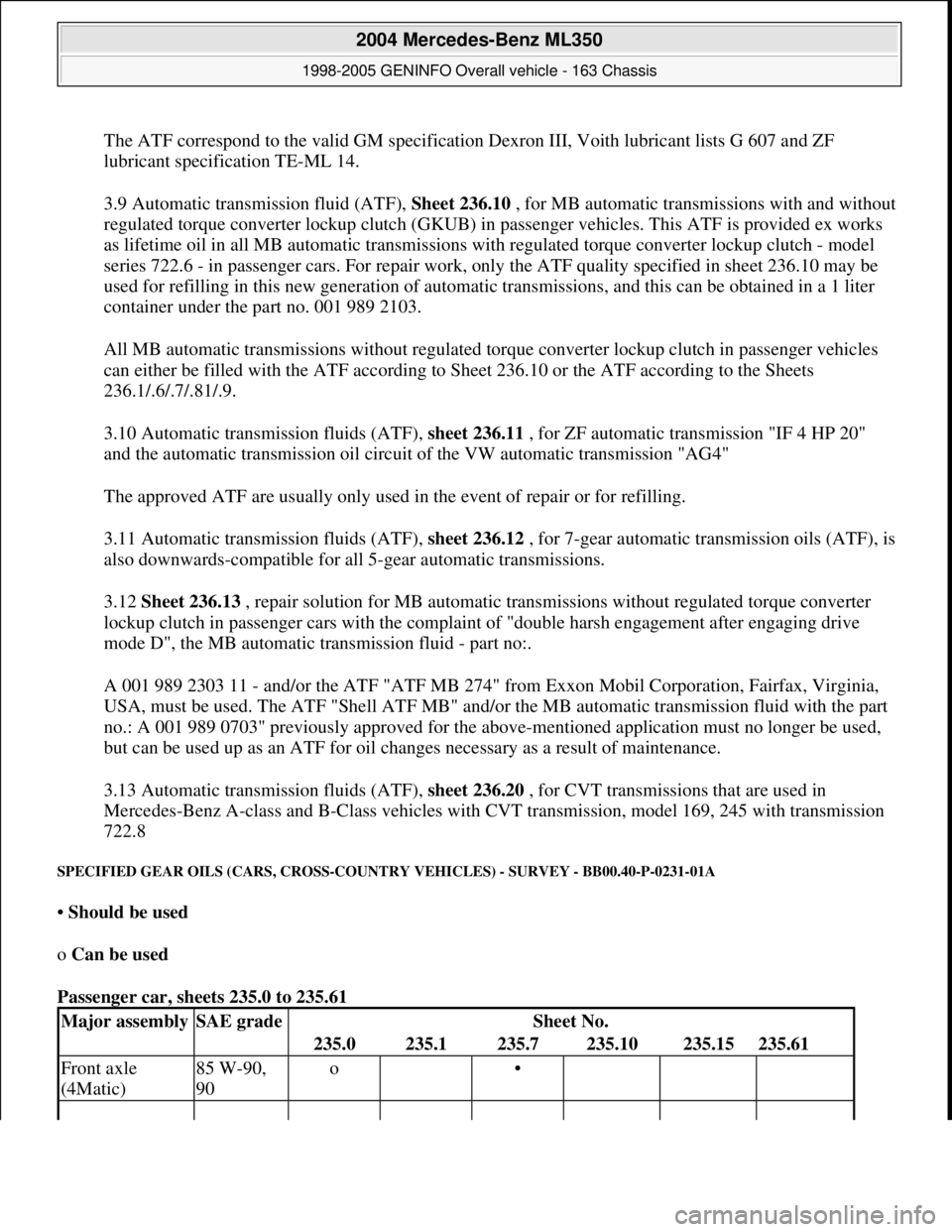
The ATF correspond to the valid GM specification Dexron III, Voith lubricant lists G 607 and ZF
lubricant specification TE-ML 14.
3.9 Automatic transmission fluid (ATF), Sheet 236.10, for MB automatic transmissions with and without
regulated torque converter lockup clutch (GKUB) in passenger vehicles. This ATF is provided ex works
as lifetime oil in all MB automatic transmissions with regulated torque converter lockup clutch - model
series 722.6 - in passenger cars. For repair work, only the ATF quality specified in sheet 236.10 may be
used for refilling in this new generation of automatic transmissions, and this can be obtained in a 1 liter
container under the part no. 001 989 2103.
All MB automatic transmissions without regulated torque converter lockup clutch in passenger vehicles
can either be filled with the ATF according to Sheet 236.10 or the ATF according to the Sheets
236.1/.6/.7/.81/.9.
3.10 Automatic transmission fluids (ATF), sheet 236.11 , for ZF automatic transmission "IF 4 HP 20"
and the automatic transmission oil circuit of the VW automatic transmission "AG4"
The approved ATF are usually only used in the event of repair or for refilling.
3.11 Automatic transmission fluids (ATF), sheet 236.12 , for 7-gear automatic transmission oils (ATF), is
also downwards-compatible for all 5-gear automatic transmissions.
3.12 Sheet 236.13 , repair solution for MB automatic transmissions without regulated torque converter
lockup clutch in passenger cars with the complaint of "double harsh engagement after engaging drive
mode D", the MB automatic transmission fluid - part no:.
A 001 989 2303 11 - and/or the ATF "ATF MB 274" from Exxon Mobil Corporation, Fairfax, Virginia,
USA, must be used. The ATF "Shell ATF MB" and/or the MB automatic transmission fluid with the part
no.: A 001 989 0703" previously approved for the above-mentioned application must no longer be used,
but can be used up as an ATF for oil changes necessary as a result of maintenance.
3.13 Automatic transmission fluids (ATF), sheet 236.20 , for CVT transmissions that are used in
Mercedes-Benz A-class and B-Class vehicles with CVT transmission, model 169, 245 with transmission
722.8
SPECIFIED GEAR OILS (CARS, CROSS-COUNTRY VEHICLES) - SURVEY - BB00.40-P-0231-01A
• Should be used
o Can be used
Passenger car, sheets 235.0 to 235.61
Major assemblySAE gradeSheet No.
235.0235.1235.7235.10235.15235.61
Front axle
(4Matic)85 W-90,
90o •
2004 Mercedes-Benz ML350
1998-2005 GENINFO Overall vehicle - 163 Chassis
me
Saturday, October 02, 2010 3:47:56 PMPage 506 © 2006 Mitchell Repair Information Company, LLC.
Page 3158 of 4133
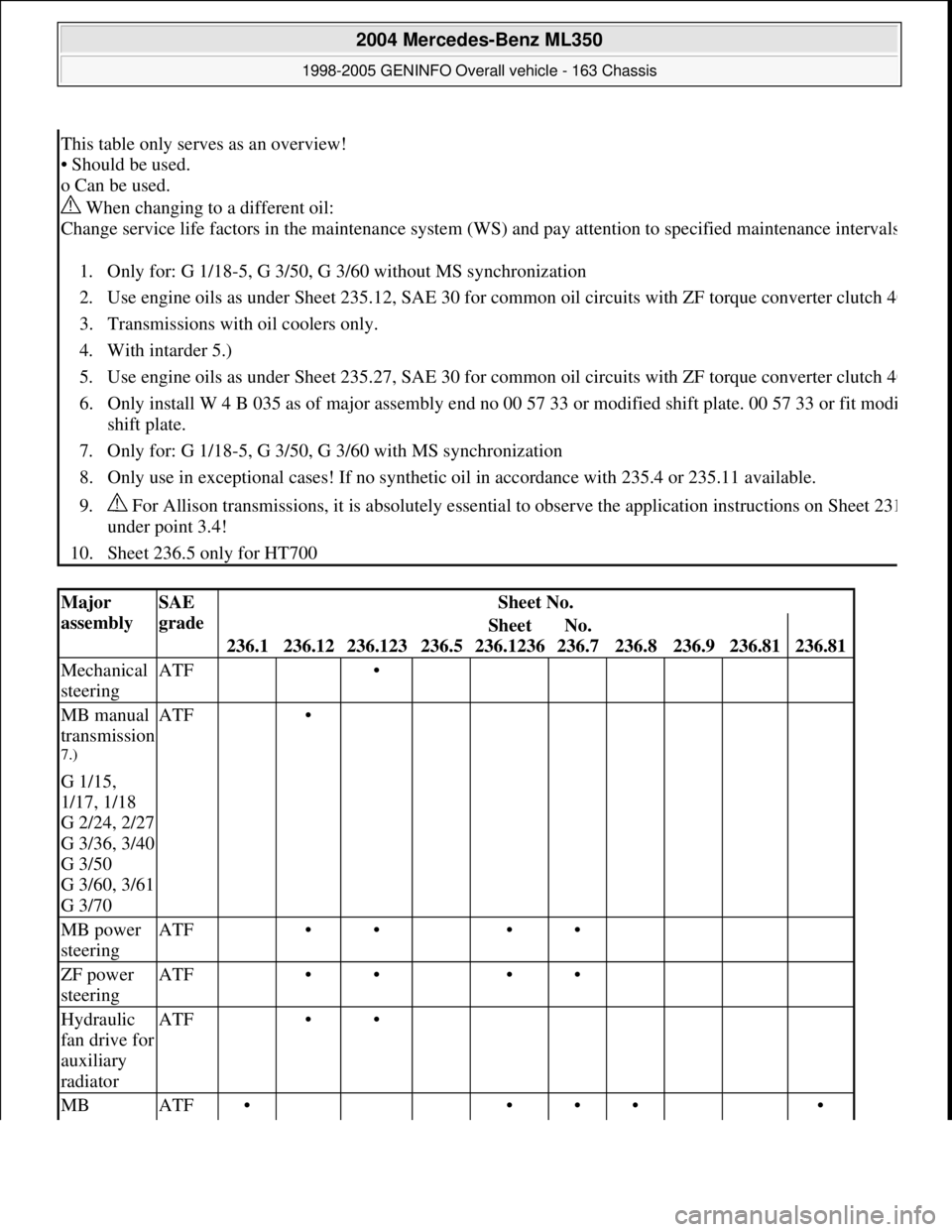
This table only serves as an overview!
• Should be used.
o Can be used.
When changing to a different oil:
Change service life factors in the maintenance system (WS) and pay attention to specified maintenance interval
s
1. Only for: G 1/18-5, G 3/50, G 3/60 without MS synchronization
2. Use engine oils as under Sheet 235.12, SAE 30 for common oil circuits with ZF torque converter clutch 4
0
3. Transmissions with oil coolers only.
4. With intarder 5.)
5. Use engine oils as under Sheet 235.27, SAE 30 for common oil circuits with ZF torque converter clutch 4
0
6. Only install W 4 B 035 as of major assembly end no 00 57 33 or modified shift plate. 00 57 33 or fit modi
shift plate.
7. Only for: G 1/18-5, G 3/50, G 3/60 with MS synchronization
8. Only use in exceptional cases! If no synthetic oil in accordance with 235.4 or 235.11 available.
9. For Allison transmissions, it is absolutely essential to observe the application instructions on Sheet 23
1
under point 3.4!
10. Sheet 236.5 only for HT700
Major
assemblySAE
gradeSheet No.
236.1236.12236.123236.5
Sheet
236.1236No.
236.7
236.8236.9236.81236.81
Mechanical
steeringATF •
MB manual
transmission
7.)
G 1/15,
1/17, 1/18
G 2/24, 2/27
G 3/36, 3/40
G 3/50
G 3/60, 3/61
G 3/70
ATF •
MB power
steeringATF •• ••
ZF power
steeringATF •• ••
Hydraulic
fan drive for
auxiliary
radiatorATF ••
MB ATF• ••• •
2004 Mercedes-Benz ML350
1998-2005 GENINFO Overall vehicle - 163 Chassis
me
Saturday, October 02, 2010 3:47:56 PMPage 513 © 2006 Mitchell Repair Information Company, LLC.
Page 3159 of 4133
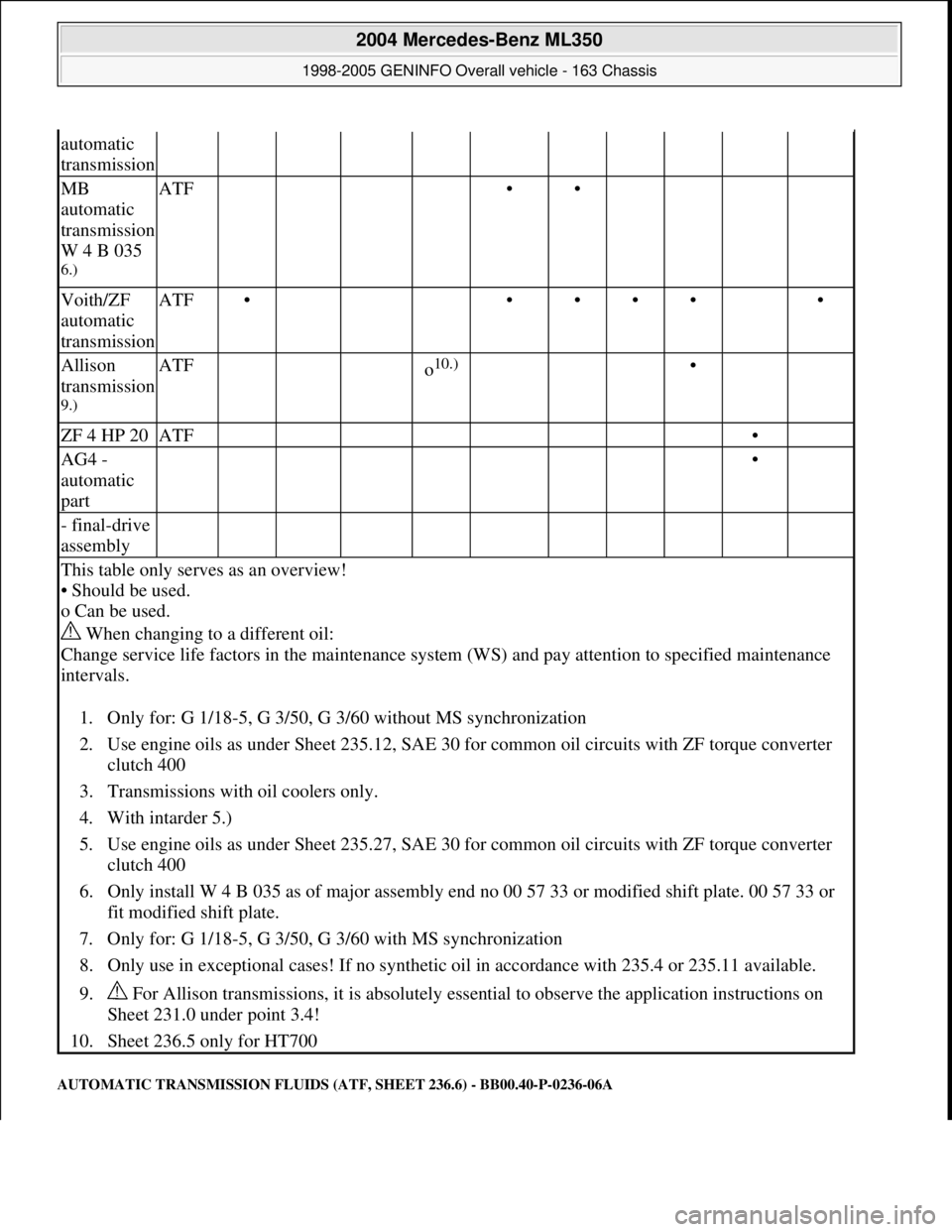
AUTOMATIC TRANSMISSION FLUIDS (ATF, SHEET 236.6) - BB00.40-P-0236-06A
automatic
transmission
MB
automatic
transmission
W 4 B 035
6.)
ATF ••
Voith/ZF
automatic
transmissionATF• •••• •
Allison
transmission
9.)
ATF o10.) •
ZF 4 HP 20ATF •
AG4 -
automatic
part •
- final-drive
assembly
This table only serves as an overview!
• Should be used.
o Can be used.
When changing to a different oil:
Change service life factors in the maintenance system (WS) and pay attention to specified maintenance
intervals.
1. Only for: G 1/18-5, G 3/50, G 3/60 without MS synchronization
2. Use engine oils as under Sheet 235.12, SAE 30 for common oil circuits with ZF torque converter
clutch 400
3. Transmissions with oil coolers only.
4. With intarder 5.)
5. Use engine oils as under Sheet 235.27, SAE 30 for common oil circuits with ZF torque converter
clutch 400
6. Only install W 4 B 035 as of major assembly end no 00 57 33 or modified shift plate. 00 57 33 or
fit modified shift plate.
7. Only for: G 1/18-5, G 3/50, G 3/60 with MS synchronization
8. Only use in exceptional cases! If no synthetic oil in accordance with 235.4 or 235.11 available.
9. For Allison transmissions, it is absolutely essential to observe the application instructions on
Sheet 231.0 under point 3.4!
10. Sheet 236.5 only for HT700
2004 Mercedes-Benz ML350
1998-2005 GENINFO Overall vehicle - 163 Chassis
me
Saturday, October 02, 2010 3:47:56 PMPage 514 © 2006 Mitchell Repair Information Company, LLC.
Page 3169 of 4133
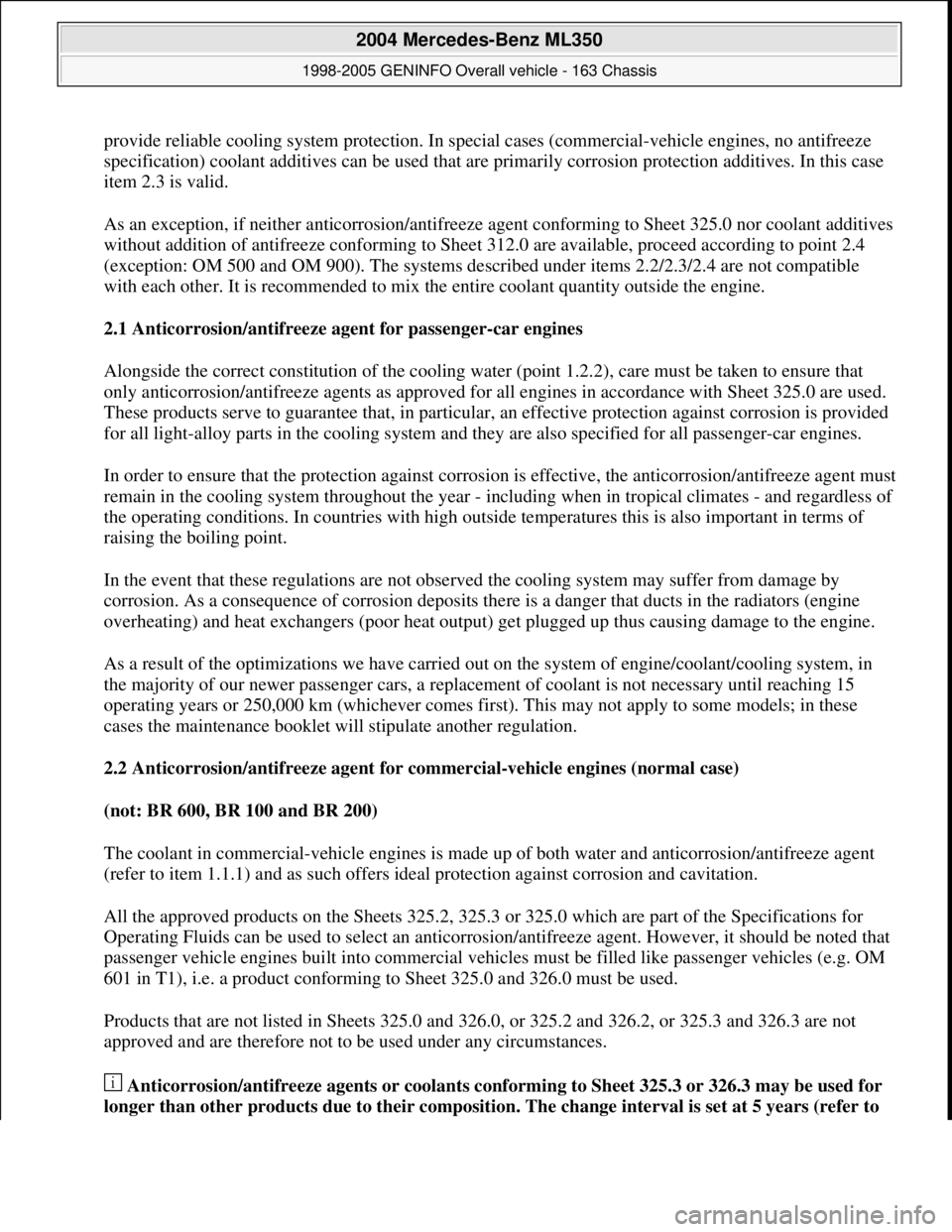
provide reliable cooling system protection. In special cases (commercial-vehicle engines, no antifreeze
specification) coolant additives can be used that are primarily corrosion protection additives. In this case
item 2.3 is valid.
As an exception, if neither anticorrosion/antifreeze agent conforming to Sheet 325.0 nor coolant additives
without addition of antifreeze conforming to Sheet 312.0 are available, proceed according to point 2.4
(exception: OM 500 and OM 900). The systems described under items 2.2/2.3/2.4 are not compatible
with each other. It is recommended to mix the entire coolant quantity outside the engine.
2.1 Anticorrosion/antifreeze agent for passenger-car engines
Alongside the correct constitution of the cooling water (point 1.2.2), care must be taken to ensure that
only anticorrosion/antifreeze agents as approved for all engines in accordance with Sheet 325.0 are used.
These products serve to guarantee that, in particular, an effective protection against corrosion is provided
for all light-alloy parts in the cooling system and they are also specified for all passenger-car engines.
In order to ensure that the protection against corrosion is effective, the anticorrosion/antifreeze agent must
remain in the cooling system throughout the year - including when in tropical climates - and regardless of
the operating conditions. In countries with high outside temperatures this is also important in terms of
raising the boiling point.
In the event that these regulations are not observed the cooling system may suffer from damage by
corrosion. As a consequence of corrosion deposits there is a danger that ducts in the radiators (engine
overheating) and heat exchangers (poor heat output) get plugged up thus causing damage to the engine.
As a result of the optimizations we have carried out on the system of engine/coolant/cooling system, in
the majority of our newer passenger cars, a replacement of coolant is not necessary until reaching 15
operating years or 250,000 km (whichever comes first). This may not apply to some models; in these
cases the maintenance booklet will stipulate another regulation.
2.2 Anticorrosion/antifreeze agent for commercial-vehicle engines (normal case)
(not: BR 600, BR 100 and BR 200)
The coolant in commercial-vehicle engines is made up of both water and anticorrosion/antifreeze agent
(refer to item 1.1.1) and as such offers ideal protection against corrosion and cavitation.
All the approved products on the Sheets 325.2, 325.3 or 325.0 which are part of the Specifications for
Operating Fluids can be used to select an anticorrosion/antifreeze agent. However, it should be noted that
passenger vehicle engines built into commercial vehicles must be filled like passenger vehicles (e.g. OM
601 in T1), i.e. a product conforming to Sheet 325.0 and 326.0 must be used.
Products that are not listed in Sheets 325.0 and 326.0, or 325.2 and 326.2, or 325.3 and 326.3 are not
approved and are therefore not to be used under any circumstances.
Anticorrosion/antifreeze agents or coolants conforming to Sheet 325.3 or 326.3 may be used for
longer than other products due to their composition. The change interval is set at 5 years (refer to
2004 Mercedes-Benz ML350
1998-2005 GENINFO Overall vehicle - 163 Chassis
me
Saturday, October 02, 2010 3:47:57 PMPage 524 © 2006 Mitchell Repair Information Company, LLC.
Page 3175 of 4133
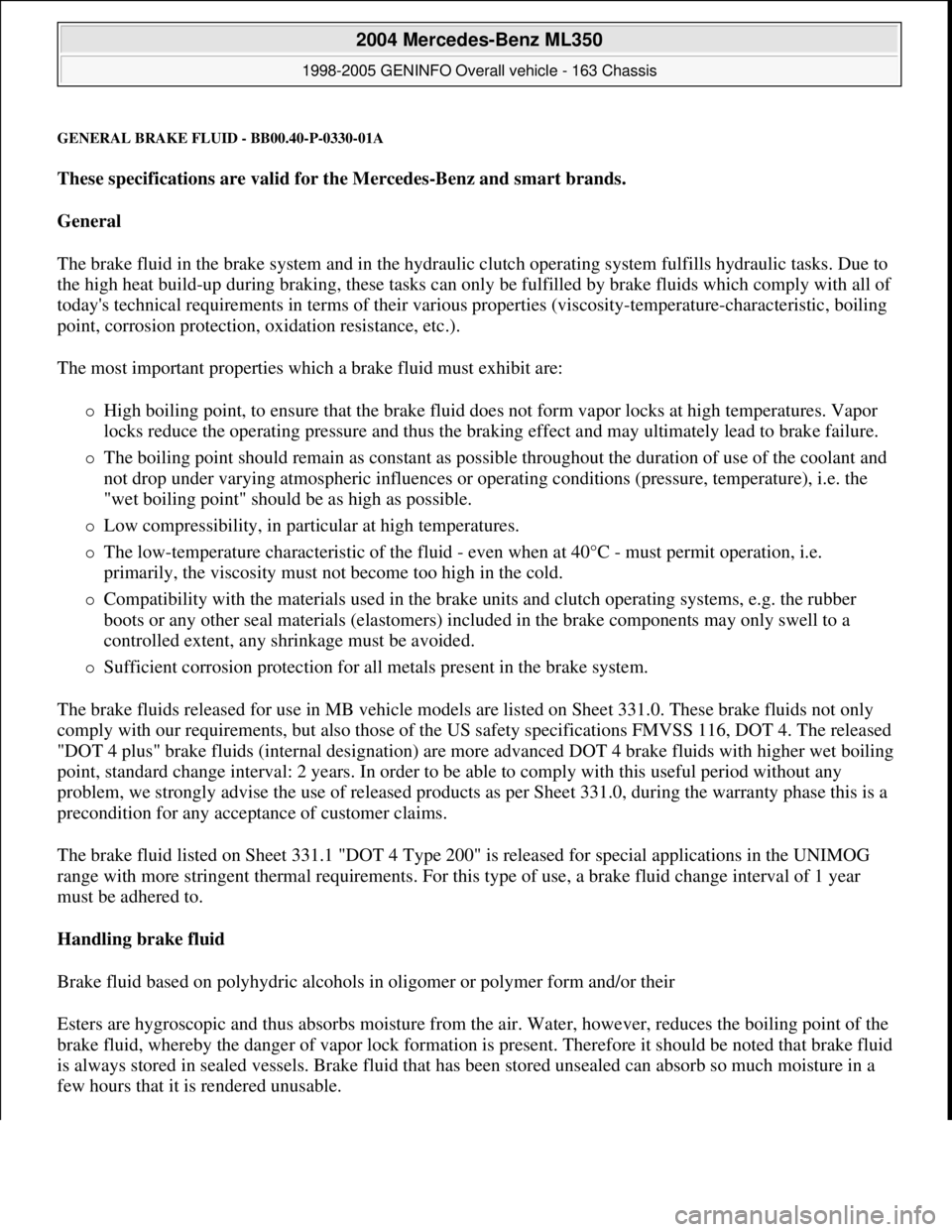
GENERAL BRAKE FLUID - BB00.40-P-0330-01A
These specifications are valid for the Mercedes-Benz and smart brands.
General
The brake fluid in the brake system and in the hydraulic clutch operating system fulfills hydraulic tasks. Due to
the high heat build-up during braking, these tasks can only be fulfilled by brake fluids which comply with all of
today's technical requirements in terms of their various properties (viscosity-temperature-characteristic, boiling
point, corrosion protection, oxidation resistance, etc.).
The most important properties which a brake fluid must exhibit are:
High boiling point, to ensure that the brake fluid does not form vapor locks at high temperatures. Vapor
locks reduce the operating pressure and thus the braking effect and may ultimately lead to brake failure.
The boiling point should remain as constant as possible throughout the duration of use of the coolant and
not drop under varying atmospheric influences or operating conditions (pressure, temperature), i.e. the
"wet boiling point" should be as high as possible.
Low compressibility, in particular at high temperatures.
The low-temperature characteristic of the fluid - even when at 40°C - must permit operation, i.e.
primarily, the viscosity must not become too high in the cold.
Compatibility with the materials used in the brake units and clutch operating systems, e.g. the rubber
boots or any other seal materials (elastomers) included in the brake components may only swell to a
controlled extent, any shrinkage must be avoided.
Sufficient corrosion protection for all metals present in the brake system.
The brake fluids released for use in MB vehicle models are listed on Sheet 331.0. These brake fluids not only
comply with our requirements, but also those of the US safety specifications FMVSS 116, DOT 4. The released
"DOT 4 plus" brake fluids (internal designation) are more advanced DOT 4 brake fluids with higher wet boiling
point, standard change interval: 2 years. In order to be able to comply with this useful period without any
problem, we strongly advise the use of released products as per Sheet 331.0, during the warranty phase this is a
precondition for any acceptance of customer claims.
The brake fluid listed on Sheet 331.1 "DOT 4 Type 200" is released for special applications in the UNIMOG
range with more stringent thermal requirements. For this type of use, a brake fluid change interval of 1 year
must be adhered to.
Handling brake fluid
Brake fluid based on polyhydric alcohols in oligomer or polymer form and/or their
Esters are hygroscopic and thus absorbs moisture from the air. Water, however, reduces the boiling point of the
brake fluid, whereby the danger of vapor lock formation is present. Therefore it should be noted that brake fluid
is always stored in sealed vessels. Brake fluid that has been stored unsealed can absorb so much moisture in a
few hours that it is rendered unusable.
2004 Mercedes-Benz ML350
1998-2005 GENINFO Overall vehicle - 163 Chassis
me
Saturday, October 02, 2010 3:47:57 PMPage 530 © 2006 Mitchell Repair Information Company, LLC.